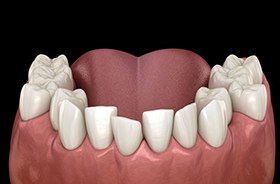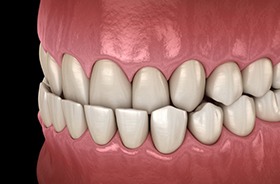Invisalign® – Lebanon, NH
The Convenient Path to Straighter, Healthier Teeth
Many adults know they need orthodontic treatment, but they do not wish to commit to traditional metal braces because they are concerned about the way braces look. For such individuals, Invisalign® offers a convenient alternative. This treatment uses clear, practically invisible aligners to reposition teeth — no metal brackets and wires required. At Santavicca Dental Professionals, we are proud to offer Invisalign® to help our patients achieve straighter, healthier, and more attractive teeth.
How Invisalign® Works
If you are a candidate for Invisalign®, your cosmetic dentist will take images and impressions of your teeth, which will serve as the basis for designing a series of custom, clear aligners. After the Invisalign® laboratory creates your aligners, you will wear each one for 20 – 22 hours each day for about two weeks before you graduate to the next one. Each aligner will apply constant, gentle pressure to your teeth and move them a bit closer to their ideal positions. After you work your way through all of your aligners, you will have a healthier and more functional mouth.
Throughout your treatment period, you will come to us for periodic checkups so we can assess your progress with Invisalign® and provide you with the next few aligners in your series. These checkups usually only take a few minutes; you might even be able to stop in during your lunch break for an appointment.
Benefits of Invisalign

Invisalign is a popular treatment because it offers a multitude of benefits — much more so than traditional metal braces. Its subtle appearance and convenience are just the beginning! During your consultation, we can answer your questions about how it may be able to help you personally. In the meantime, you can gain a general overview of its many advantages by reading the content below. Invisalign is truly a treatment that you can get excited about!
Discreet Appearance

One of the biggest complains about traditional metal braces is their noticeable appearance. Invisalign, on the other hand, is very discreet. Since it does not call attention to itself, it is usually not the first thing that onlookers notice. You can maintain an open and confident smile whether you are posing for selfies, meeting new people, or simply running errands around town.
Enhanced Comfort

Invisalign aligners are designed to rest as comfortably as possible against the soft tissues in the mouth. There are no metal brackets and wires to irritate your tongue or cheeks. Plus, because Invisalign is gentler than traditional braces, you can expect less oral soreness and tenderness as your teeth gradually move into their proper positions.
No Dietary Restrictions

Invisalign aligners are removable. At mealtimes, all you have to do is take your trays out of your mouth, enjoy whatever food you are craving, tend to your oral hygiene, and put your aligners back on your teeth. You can even consume foods that are off-limits with traditional braces, like popcorn and sticky candies. (Of course, it is still important to exercise caution and wisdom when choosing what to eat, but there is nothing wrong with an occasional treat!)
Easy Oral Hygiene

With traditional braces, it can be a bit challenging to clean around all those brackets and wires. Conversely, Invisalign is removable, so you can brush and floss your teeth using normal techniques. Since you should clean your smile after each meal, this convenient feature is especially valuable!
Fast Follow-Up Appointments

In most cases, Invisalign follow-up appointments are quite brief — quick enough to complete during your lunch break! Usually, we just check on your progress, answer any questions you may have, and provide you with the next set of aligners in your series. Longer appointments are only necessary if we are making treatment adjustments or completing other lengthier tasks.
Reliable Results and Non-Invasive Treatment

Invisalign utilizes state-of-the-art technology to produce reliable, predictable tooth movements. It consistently achieves desirable results, and it does so in a non-invasive way. As long as you comply with treatment instructions, it is very likely that you will enjoy a smooth and complication-free journey with Invisalign.
Who Can Invisalign Help?

Most adults and many responsible adolescents with mildly or moderately misaligned teeth are candidates for Invisalign. We invite you to schedule a consultation with our team so we can examine your teeth and confirm that Invisalign is right for you. Once we do so, we can get started on planning your treatment. Here are a few of the specific types of dental misalignment that we commonly use Invisalign to address:
Crowded Teeth

Crowded, overlapping teeth can trap food between them and increase your chances of developing numerous oral health issues, including cavities, gum disease, bad breath, and more. Often, this problem only worsens with age as the teeth naturally shift. Invisalign is usually able to move the teeth in a way that gives each of them the space needed to function at its best.
Gaps Between Teeth

Whether they are caused by poor bone development, thumb sucking during childhood, or other factors, large gaps between the teeth can leave your gums vulnerable to injury and irritation. In many cases, Invisalign is able to move the teeth closer together so they function better and look more appealing.
Overbite

Your upper teeth should rest slightly in front of your bottom teeth. A severe overbite, however, can lead to several problems, such as speech issues, jaw pain, and more. If you have an overbite, we may be able to use Invisalign, along with appropriate accessories, to correct the alignment of your teeth and jaw.
Underbite

If your bottom teeth rest in front of your top teeth, you have what is known as an underbite. Often, genetics, oral trauma, or certain childhood habits (such as thumb sucking) contribute to the development of an underbite. Without treatment, this condition could increase your risk of sleep apnea, as well as difficulties with speaking and chewing. In many cases, Invisalign, along with key accessories, is able to correct cases of underbite.
Crossbite

If some of your bottom teeth sit in front of your top teeth, you have a crossbite. Genetics, poor oral habits, and the early loss of baby teeth can all be factors in the development of a crossbite. Speech problems, chewing difficulties, and more can result if this issue is not treated. Invisalign is often able to reposition the teeth in a way that corrects a crossbite.
Open Bite

If your front teeth cannot touch even when your back teeth are closed, you have an open bite. Whether it is the result of poor bone development or other factors, this issue can cause speech and chewing difficulties and other challenges. Fortunately, Invisalign aligners can often close an open bite and improve oral function.
Living with Invisalign Aligners

Invisalign is a convenient treatment that is designed to fit into even the busiest lifestyles! Of course, you will still need to make some minor adjustments to your routine in order to make sure you are getting the most out of your aligners. What specific steps will you need to take for your treatment to succeed? Our team can answer your questions during your consultation. In the meantime, here is a general overview of what you should do:
Wearing Your Trays

Remember that your Invisalign aligner trays only work when you are wearing them, so it is important to keep them in your mouth as much as possible. The only times when you should remove them are when you eat and when you need to care for your oral hygiene. Your target should be to wear your aligners for at least 20 – 22 hours each day.
After two weeks or so of wearing a set of aligners, you will get to move forward to the next set so your teeth can continue to progress toward their ideal positions.
Cleaning Your Aligners

It is important to keep your aligners clean. Otherwise, bacteria and food particles could stain them and start to cause odors. Try to make it your habit to brush your aligners each night with a soft brush and clear, mild soap. Regularly soaking them with Invisalign cleaning crystals is also strongly recommended.
When you remove your aligners at mealtimes, rinse them before placing them back in your mouth.
Eating & Drinking

There are no restrictions on what you are allowed to eat while undergoing Invisalign treatment. You should remove your aligners whenever you eat or drink anything other than plain water. Otherwise, your Invisalign could incur damage or stains. When you eat, be sure to store your aligners in a designated case. Do not wrap them in a napkin because you might accidentally throw them away!
Losing or Damaging a Tray

If you lose or damage an Invisalign aligner tray, call our team. We may advise you to return to wearing a previous aligner so we can order a replacement for the one you can no longer use. In some cases, though, we might tell you that it is okay to move on to your next aligner a few days earlier than expected. Do not start wearing your next aligner without our explicit direction; skipping ahead too early could cause significant discomfort!
Routine Check-Ins

You should plan to visit us every 4 – 8 weeks or so for a brief check-in appointment. We will see how your teeth are progressing, answer any questions you may have, and provide you with the next set of aligners in your series. Occasionally, we might need to revise your treatment plan in order to keep you on track toward the desired results.
Most Invisalign check-ins last just 15 minutes or so, but revision appointments take longer.
Understanding the Cost of Invisalign®

The cost of Invisalign® in Lebanon varies from patient to patient. When you visit us for your consultation, we will provide you with an estimate for the price you may have to pay. We will also help you explore how your insurance or financing may be able to help you fit Invisalign® into your budget. Although Invisalign® costs a significant amount of money, it is a worthwhile investment that could dramatically improve your oral health and bolster your confidence.
Factors that Affect the Cost of Invisalign®
A few factors that influence the cost of Invisalign® include:
- The number of aligners needed. More extensive treatment requires more aligners and may cost more. Similarly, straightening both dental arches rather than just one calls for more aligners and is likely to incur a higher cost.
- Some patients require special accessories, like button attachments and rubber bands, to correct bite problems or other issues.
- If you accidentally lose an aligner, you may have to pay for a replacement. Failing to wear your aligners may extend your treatment timeline and lead to higher overall costs.
Invisalign® vs. DIY Aligners: Cost vs. Value
DIY aligners are more popular than ever. The idea of ordering your clear aligners through the mail may seem convenient and appealing. Plus, these systems usually cost around $2,000, making them significantly cheaper than most Invisalign® cases.
However, it is important to think about cost vs. value. With Invisalign®, you get the personalized support of a highly trained dental team. The aligners are made out of patented materials, and the results are predictable. DIY aligners are often made out of cheap plastics. Plus, you receive little to no in-person assistance. Even a small mistake in your treatment could lead to less than desirable results. You might end up spending a large amount of money to correct problems caused by an unfortunate incident with DIY aligners. It is better to invest in high-quality treatment from the outset, rather than take a gamble on a product with an uncertain outcome.
Does Dental Insurance Cover Invisalign®?
Some dental insurance plans include a lifetime maximum for orthodontic treatment, and Invisalign® is usually included. If your policy applies, it might reduce your out-of-pocket costs by $1,000 or more. Our team is happy to file insurance claims for patients, and we will help you with getting pre-authorization prior to beginning your treatment if necessary. If you cannot use your insurance for Invisalign®, you might be able to tap into your FSA or HSA to help you afford it.
Options for Making Invisalign® Affordable
As your Invisalign® dentist in Lebanon, we want to help you afford your treatment! In addition to assisting you with insurance, we offer a few provisions that might play a role in fitting Invisalign® into your budget:
- Most patients qualify for low-interest financing through CareCredit, a third-party lender. Our team can guide you through the application process.
- Essential Dental Plan. This discount plan provides reduced costs on virtually all the services we offer.
Are you eager to straighten your teeth with Invisalign®? Call us today to find out how our team can help you navigate the financial aspects of your care.
Invisalign® FAQs

If you are thinking about straightening your teeth with Invisalign® in Lebanon, you have an exciting journey ahead of you. Before you schedule your consultation, however, you may want to gather more information about the treatment and what you can expect from it. To help you out, we have put together a list of some frequently asked questions about Invisalign®, along with succinct answers. If you would like further explanation about anything you discover here, give our office a call. We look forward to speaking with you!
How Long Does Invisalign® Take?
The average treatment time with Invisalign® is 12 months. However, your case might require significantly more or less time. When you come in for your consultation with your cosmetic dentist in Lebanon, our team will assess the positioning of your teeth and provide you with an estimated timeline for your treatment. Mild cases of misalignment may take a relatively short period of time to correct, whereas more complex orthodontic issues typically require a lengthier treatment. In most cases, Invisalign® takes less time than traditional braces.
Does Invisalign® Hurt?
Invisalign® aligners are made out of a smooth, patented form of plastic that is designed to be as comfortable as possible. There are no metal parts to irritate your cheeks or tongue, and the edges of the aligners are unlikely to bother your gum tissue.
However, you should keep in mind that orthodontic treatment works by applying pressure to the teeth. Naturally, this can cause a degree of discomfort, especially when you make the transition to a new aligner. You can mitigate any pain by taking over the counter medicines (ibuprofen tends to work well), sipping on cool water, and switching to a new aligner at night so you can sleep through the first part of the adjustment period.
What Happens After Invisalign®?
After you make your way through all of your aligners, you will visit our office so we can verify your results. Once we are satisfied that your teeth are correctly positioned, we will provide you with a retainer. A retainer is a small device whose purpose is to prevent the teeth from drifting out of place again. At first, you should wear it full-time (20 – 22 hours each day). After several months, however, we may give you the go-ahead to wear it only at night.
What if My Invisalign® Broke?
Invisalign® aligners are built to be durable, but accidents happen from time to time that can cause them to break, crack, or get scratched. Often, if there are small hairline cracks, you can still wear your aligner — just be extra careful not to worsen the damage when you are taking it in and out of your mouth. If the damage is more significant, do not attempt to wear the aligner. Rather, give us a call. We might advise you to move ahead to your next aligner a few days early. It is also possible that we will tell you to wear a previous aligner until we can order a replacement for the one that is no longer functional.
What Do Invisalign Trays Look Like When Worn?
Invisalign trays are very discreet. They are designed not to call a lot of attention to themselves, so you can expect to be able to smile with confidence as you face a variety of social and professional settings.
However, they are not totally invisible. Your teeth may look a bit bigger than usual, and the aligners will be noticeable for anyone who looks closely at your teeth. Invisalign may also use accessories, such as rubber bands and buttons, that are not transparent.
What Are Invisalign Attachments?
In the early days of Invisalign, it was reserved for very mild cases of misalignment. Attachments have played a major role in expanding candidacy for Invisalign! These are small, tooth-colored bumps that we bond onto the teeth. Their job is to guide the force of the aligners, which facilitates more efficient and effective tooth movements.
The process of placing and removing the attachments is easy. During your consultation, our Lebanon team may be able to let you know if you will need them.
Can You Get Invisalign After Braces?
Many patients can get Invisalign after braces.
For example, if you want Invisalign but have severe dental misalignment, you might need to start your treatment with braces. Later, after the positioning of your teeth has been partially corrected, you may be able to switch to Invisalign.
If you had braces in the past but your teeth have now started to drift out of place, Invisalign could be a convenient way to get them back where they belong.
Who Is Not Eligible for Invisalign?
Invisalign is a great choice for many patients, but it is not right for everyone. For example, it might not be right for you if:
- You are younger than 13 years old.
- Your dental misalignment is severe or complex.
- Your teeth are too small or misshapen to support Invisalign aligners.
- You do not want to remember to wear your aligners for the required 20 – 22 hours each day.
- You smoke.
- You have to wear a mouthguard at night to prevent teeth grinding.
Can You Eat with Invisalign Trays In?
No, you should never eat while wearing your Invisalign trays. Doing so could damage your aligners or cause them to become stained. Food might even get trapped in them, which could significantly increase your risk of dental decay and bad breath. The only thing you should consume while wearing your aligners is cool or room temperature water.
In contrast, when you remove your aligners, you are free to eat whatever you want. This is different from traditional braces, which come with a long list of dietary restrictions.
